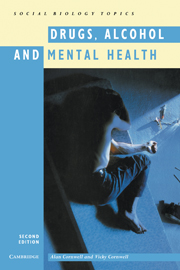Book contents
- Frontmatter
- Contents
- Preface
- 1 Drugs and drug abuse
- 2 Socially acceptable drugs
- 3 Misuse of prescribed and related drugs
- 4 Hallucinogenic drugs
- 5 Opiates and other narcotics
- 6 The biology of alcohol
- 7 The problems of alcohol use
- 8 Prevention and control of alcohol problems
- 9 Help for problem drinkers
- 10 Mental health and mental illness
- 11 Alzheimer's disease and other dementias
- 12 Other mental illnesses
- Further reading
- Index
2 - Socially acceptable drugs
Published online by Cambridge University Press: 05 June 2012
- Frontmatter
- Contents
- Preface
- 1 Drugs and drug abuse
- 2 Socially acceptable drugs
- 3 Misuse of prescribed and related drugs
- 4 Hallucinogenic drugs
- 5 Opiates and other narcotics
- 6 The biology of alcohol
- 7 The problems of alcohol use
- 8 Prevention and control of alcohol problems
- 9 Help for problem drinkers
- 10 Mental health and mental illness
- 11 Alzheimer's disease and other dementias
- 12 Other mental illnesses
- Further reading
- Index
Summary
Introduction
Thousands of substances which come within the definition of ‘drugs’ are in use every day and many of them in enormous quantities. For the purposes of this book, drugs which are used under medical supervision will be ignored, but this still leaves a large number. Most of these have little noticeable effect on the nervous system and are unlikely to cause any severe physical effects unless used vastly to excess. For example, antiperspirants can, if used too much, cause skin problems, and throat lozenges or cough medicines should not be used more frequently than indicated by the instructions on the container. The most important self-administered drugs and by far the most frequently used are caffeine, minor pain-killers (aspirin and paracetamol), nicotine and alcohol.
Caffeine
This drug is found in four of the most commonly used drinks in our society, that is tea, coffee, cola and cocoa. Tea and cocoa also contain other drugs with similar effects. These are theophylline in tea and theobromine in cocoa.
Caffeine is a stimulant drug. It acts in the brain by reducing the breakdown of cyclic AMP and so acts on the catecholamine pathways. Catecholamines (adrenalin and noradrenalin) control stimulatory pathways and act by increasing the levels of cyclic AMP in the brain cells. The noticeable effects of caffeine are to remove feelings of tiredness, increase the ability to think clearly, stimulate the heart muscle, relax the muscles of the bronchioles and also act as a diuretic. When used medically as a stimulant the usual dose is 100–300 mg.
- Type
- Chapter
- Information
- Drugs, Alcohol and Mental Health , pp. 15 - 18Publisher: Cambridge University PressPrint publication year: 1993



